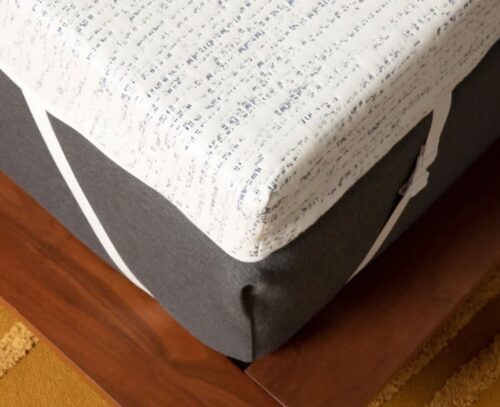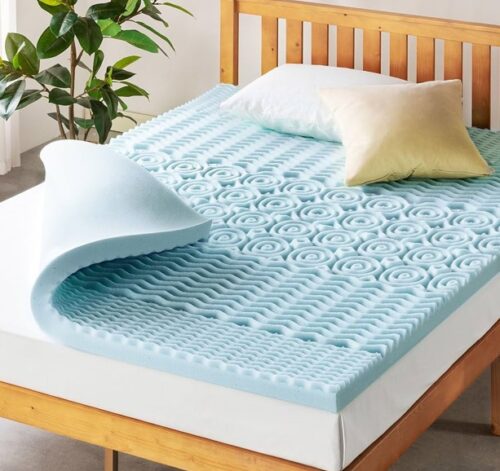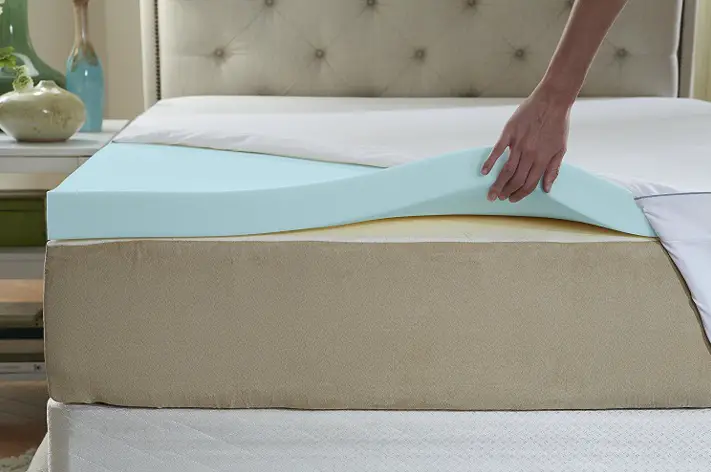Disclosure
This website is a participant in the Amazon Services LLC Associates Program, an affiliate advertising program designed to provide a means for us to earn fees by linking to Amazon.com and affiliated sites.
Memory foam mattress topper lasts between 3 to 5 years but the actual number of years that the mattress topper lasts depends on several factors.
High quality memory foam mattress toppers may last up to 8 years with proper care and maintenance. When the mattress topper is subjected to heavy use and is not taken care of, will wear out fast and may need replacement sooner.
Mattresses usually outlast the mattress topper. Whereas a mattress may last more than 10 years, you may go through 2-3 toppers in the lifetime of a single mattress.
Why Have Memory Foam Mattress Toppers Become Popular?
Its no secret that memory foam mattress toppers have a go to choice for many people who want to enhance sleep quality and need to extend the life of existing mattresses.
Memory foam mattress toppers are made from viscoelastic material, that was originally developed by NASA in the 1960s to improve aircraft cushion safety.
With continuous research and development, memory foam has become famous due to its ability to conform to the body’s shape, thereby providing a personalized support and provide relief to pressure points.
Memory foam mattress toppers have become popular due to the following reasons:
- It offers Improved comfort and support to the body
- It enhances sleep quality
- It protects and increases the mattress lifespan
- It is easy to maintenance
Factors Influencing Lifespan of Memory Foam Mattress Topper

The longevity of a memory foam mattress topper depends on several factors which we will discuss below. Individually, one factor might not influence so much how long the mattress topper lasts but when combined, they have a serious bearing on the lifespan of the mattress topper.
Here are the key factors that influence how long your memory foam mattress topper lasts:
- Foam quality: Foam is the primary component that makes memory foam mattress topper. Higher-quality foam will last longer and is likely to be able to withstand more wear and tear. Always buy a premium quality mattress topper that will have a longer lifespan.
- Thickness of the Topper: The thickness of mattress topper determines the kind of support the mattress topper offers. Thicker mattress toppers tend to last longer as they have more material to distribute weight and pressure. A mattress topper that is 1″ to 2″ thick will wear out sooner compared to a 3″ or higher toppers.
- How often the mattress topper is used: Regular use mattress toppers tend to wear out faster compared to those that are used occasionally. The constant weight and pressure every so often will cause the foam to break down more quickly.
- Body Weight: The weight of the person sleeping on the mattress topper will affect its longevity. Heavier individuals exert more pressure and cause more compression of the foam, thereby causing it to wear out fast.
- Proper Maintenance and Care: Memory foam requires low maintenance but proper cleaning, storage, protection, and care can significantly extend the life of the mattress topper.
- Underlying Mattress Condition: Since the mattress topper is used on top of a mattress, the condition of the underlying mattress has a serious bearing on the life of the mattress topper. When the mattress is sagging and does not support the mattress topper properly, it will affect the topper’s performance and longevity.
- Environmental Factors: A mattress topper does not live in a vacuum and environmental factors such as the temperature, humidity, and exposure to direct sunlight will impact the foam’s structure over time thereby influencing how long it will last.
- Sleep Position: People who sleep consistently in the same position leave a permanent indentation on the mattress topper, especially if you’re a side sleeper or heavier individual. These indentations will cause the topper to wear out fast and last less period.
Signs That Your Memory Foam Mattress Topper Needs Replacing
No matter how well you take care of your memory foam mattress topper, a time will come when you will surely need to replace the mattress topper. The signs that you need to replace the mattress topper will start appearing gradually and its good if you know what signs to look out for and start preparing and budgeting early on.
Here are the 8 important signs that your mattress topper needs replacing:
- Mattress topper starts sagging or has Indentations: When you start noticing permanent dips or indentations in the foam that don’t bounce back, it’s a clear sign that the topper is losing its shape and supportive properties and may need replacement.
- Discomfort During Sleep: When you start noticing that you’re no longer getting a good night’s sleep or you start experiencing new aches and pains, that’s a sign that your mattress topper may no longer be providing adequate support and may need replacement.
- Odors or Discoloration: When you start noticing persistent unpleasant smells or visible stains and discoloration that are hard to remove during cleaning of a memory foam mattress topper, can indicate the growth of mold, mildew, or bacteria, which can be harmful to your health.
- Visible Wear and Tear: When on closer inspection of the mattress topper you start seeing signs of physical damage such as tears, cracks, or crumbling foam, then that’s a clear indication that the mattress topper needs replacement.
- Loss of Responsiveness: A good memory foam mattress topper responds to the pressure applied to eat and molds accordingly. When the foam no longer responds to your body heat and pressure and does not molding to your shape, it signifies that it has lost its essential memory foam properties and may need replacement
- Age: Memory foam mattress as indicated last between 3-5 years. If your topper is over 5 years old it will start showing any of the above signs, and it’s time for a replacement.
- Allergies or Respiratory Issues: When you have an increase in allergy symptoms or respiratory problems, it may be as a result of dust mites or other allergens. This is especially true where these problems keep recurring even with regular cleaning of the memory foam mattress topper and it is time to start considering replacement.
- Noise: When you notice that your topper keeps making crunching or crackling sounds when you move, it’s an indication that the foam is breaking down and may need replacement.
How to Extend the Life of Memory Foam Mattress Topper

Proper maintenance and care for your memory foam mattress topper will go a long way in maximizing its lifespan and ensure it continues to provide optimal comfort for as long as possible.
Here are a few maintenance tips worth considering:
- Use a mattress protector: A mattress protector especially a waterproof one, will help shield the mattress topper from spills, stains, dust, and sweat.
- Rotate the mattress topper Regularly: Sleeping on one spot on the mattress topper is a recipe for quick wear and tear. Rotating the mattress topper 180 degrees every few months will help in distributing wear evenly.
- Proper Cleaning: Ensure you clean your mattress topper properly from time to time. Vacuum the topper regularly to remove dust and debris.Perform spot cleaning with a mixture of equal parts water and vinegar to remove stains. To remove odors, sprinkle baking soda evenly over the mattress topper and let it sit for at least 8hrs or overnight, then vacuum thoroughly.
- Air the mattress topper It Out: From time to time, you will need to remove the memory foam mattress topper and put it out in a place where there is free flow of air and allow it to air out to prevent moisture buildup and odors.
- Avoid Excessive Weight: Excess weight will cause damage to the structure of the foam. Avoid sitting or standing on the topper or putting heaver objects on top as this will cause premature wear and indentations.
- Have a Supportive Base: Always ensure that your mattress, where the mattress topper sits on is in good condition and can support the mattress topper adequately. A sagging mattress will affect the mattress topper’s performance.
- Control Room Environment: Extreme environment will cause the mattress topper to wear out fast. Keeping your bedroom at a moderate temperature and humidity levels is advised as extreme conditions can affect the foam’s structure.
- Handle with Care: Foam is delicate and when moving or storing memory foam mattress topper, avoid folding or bending it sharply as these actions will damage to the foam structure.
- Use Appropriate Bedding: Protecting the mattress cover is paramount and using sheets that fit properly over both the mattress and topper will help reduce friction and shifting.
- Clean Spills Immediately: If accidents happen and you spill liquid on the mattress topper, clean them up promptly to prevent the liquid from seeping through to the foam.
How Long Do Other Toppers Last?
While memory foam is a common and a popular choice for mattress topper, its not the only type of mattress topper. Always be conscious of how other mattress toppers compare to memory foam mattress topper. Here is how they compare:
Memory Foam Toppers
- Average lifespan: 3-5 years
- Pros: Excellent pressure relief, motion isolation
- Cons: Can retain heat, may off-gas initially
Feather/Down Toppers
- Average lifespan: 1-2 years
- Pros: Soft and luxurious feel, good for side sleepers
- Cons: Require frequent fluffing, may trigger allergies
Latex Toppers
- Average lifespan: 5-15 years
- Pros: Durable, naturally hypoallergenic, cooler than memory foam
- Cons: More expensive, can be heavy
Wool Toppers
- Average lifespan: Up to 10 years
- Pros: Natural temperature regulation, moisture-wicking
- Cons: Can be expensive, may feel too firm for some
Polyfoam Toppers
- Average lifespan: 2-3 years
- Pros: Affordable, various firmness options
- Cons: Less durable than memory foam or latex
Gel-Infused Foam Toppers
- Average lifespan: 3-5 years
- Pros: Better cooling properties than traditional memory foam
- Cons: May still retain some heat
Memory foam mattress toppers offer a balanced combination of durability and performance. The foam mattress topper may not last as long as latex or wool toppers, they typically outlast feather/down and polyfoam toppers while providing excellent pressure relief and support.
Your choice between these toppers will largely depend on your specific needs, budget, and preferences. Factors such as sleeping position, temperature sensitivity, and any specific health concerns should be on top of your mind when selecting a mattress topper.
When to Replace Your Entire Mattress
A mattress topper will significantly improve your sleep experience and extend the life of your mattress, but at one point or another, replacing the entire mattress maybe the only option.
You need to understand the signs that indicate you might need to consider a new mattress rather than just replacing the topper:
- Age of the Mattress: As the mattress ages, it will lose its structural integrity over time. When your mattress is over 8-10 years old, it surely is a good time to start thinking of a replacement, regardless of the condition of your topper.
- Persistent Discomfort: When you start experiencing consistent pain or discomfort even with a new or well-maintained mattress topper, the underlying mattress may no longer provide adequate support.
- Visible Sagging or Damage: When your mattress shows noticeable sagging, lumps, or visible damage, a mattress topper might not be able to fully compensate for these issues and its time for mattress replacement.
- Allergies or breathing problems: If you’re experiencing increased allergy symptoms or asthma attacks, your old mattress may be harboring dust mites and other allergens.
- Changes in Your Body or Lifestyle: Significant weight changes, injuries, or health conditions might necessitate a different type of mattress altogether.
- Noise: When your mattress starts making creaking or squeaking noises when you shift, it could indicate worn-out springs or other structural issues and may need replacement.
- Motion disturbance: When you can feel every movement your partner makes, your mattress has lost its motion isolation properties and may need replacement.
Conclusion
A memory foam mattress topper is designed to enhance your mattress, not replace it entirely. While toppers can address minor comfort issues and extend a mattress’s lifespan, they can’t fix major structural problems or restore a mattress that’s far past its prime.
Taking care of your memory foam mattress topper will ensure that it lasts longer and that you do not need to make a replacement. When not in use, ensure you store your mattress topper properly to avoid damaging it.
Understand signs that show your mattress topper is worn out and needs replacement and plan accordingly.

